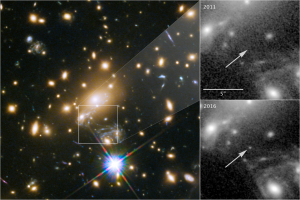The Farthest Star Helps Probe Dark Matter

Assistant Professor Patrick Kelly led a team of researchers that set a distance record and discovered the farthest individual star ever seen. The star, nicknamed Icarus, is 9 billion light-years away--halfway across the visible universe--and would ordinarily not be visible even to the most powerful telescopes. Gravitational lensing allowed the Hubble Space Telescope to pick out Icarus, whose official name is MACS 1149+2223 Lensed Star 1. The unique opportunity to study Icarus also allowed researchers to rule out one of the theories about the mystery of dark matter.
Kelly specializes in using gravitational lensing to study objects such as supernova events. "This is the first time we’re seeing a magnified, individual star," Kelly said. "You can see individual galaxies out there, but this star is at least 100 times farther away than the next individual star we can study, except for supernova explosions."
Gravitational lensing uses a massive cluster of galaxies as a natural lens in space, bending and amplifying light. Sometimes light from a single background object appears as multiple images. The light can be highly magnified, making extremely faint and distant objects bright enough to see. In a previous study, Kelly and his group used gravitational lensing to study a supernova event was seen in multiple images. They were able to use the multiple images to do a novel test of the expansion rate of the universe. They nicknamed that event SN Refsdal after the astrophysicist who first proposed that such images could be used to test the expansion of the universe.
In the case of Icarus, a natural “magnifying glass” is created by a galaxy cluster which lies between Icarus and Earth, at about 5 billion light-years away.
Detecting the amplification of a single, pinpoint background star provided a unique opportunity to test the nature of dark matter in the cluster. Dark matter is an invisible material that makes up most of the universe’s mass.
By probing what’s floating around in the foreground cluster, scientists were able to test one theory that dark matter might be made up mostly of a huge number of primordial black holes formed in the birth of the universe with masses tens of times larger than the Sun. The results of this unique test disfavor that hypothesis, because light fluctuations from the background star, monitored with Hubble for 13 years, would have looked different if there were a swarm of intervening black holes.
The research team, including Jose Diego of the Instituto de Física de Cantabria, Spain, and Steven Rodney of the University of South Carolina, Columbia, dubbed the star "Icarus," after the Greek mythological character who flew too near the Sun on wings of feathers and wax that melted. Much like Icarus, the background star had only fleeting glory as seen from Earth: It momentarily skyrocketed to 2,000 times its true brightness when temporarily magnified.
Models suggest that the tremendous brightening was probably from the gravitational amplification of a star, similar in mass to the Sun, in the foreground galaxy cluster when the star moved in front of Icarus. The star’s light is usually magnified by about 600 times due to the foreground cluster’s mass.
The team had been using Hubble to monitor a supernova in the far-distant spiral galaxy when, in 2016, they spotted a new point of light not far from the magnified supernova. From the position of the new source, they inferred that it should be much more highly magnified than the supernova.
When they analyzed the colors of the light coming from this object, they discovered it was a blue supergiant star. This type of star is much larger, more massive, hotter, and possibly hundreds of thousands of times brighter than our Sun. But at this distance, it would still be too far away to see without the amplification of gravitational lensing.
Kelly said that the team knew that they had found an individual star and not another supernova because the temperature of the object stayed the same. "The source isn’t getting hotter; it’s not exploding. The light is just being magnified," Kelly said. And that’s what you expect from gravitational lensing."
When NASA’s James Webb Space Telescope is launched, astronomers expect to find many more stars like Icarus. Webb’s extraordinary sensitivity will allow measurement of even more details, including whether these distant stars are rotating. Such magnified stars may even be found to be fairly common.
The Hubble Space Telescope is a project of international cooperation between NASA and ESA (European Space Agency). NASA’s Goddard Space Flight Center in Greenbelt, Maryland, manages the telescope. The Space Telescope Science Institute (STScI) in Baltimore, Maryland, conducts Hubble science operations. STScI is operated for NASA by the Association of Universities for Research in Astronomy, in Washington, D.C.
To read the full research paper entitled “Extreme magnification of an individual star at redshift 1.5 by a galaxy-cluster lens,” visit the Nature Astronomy website.